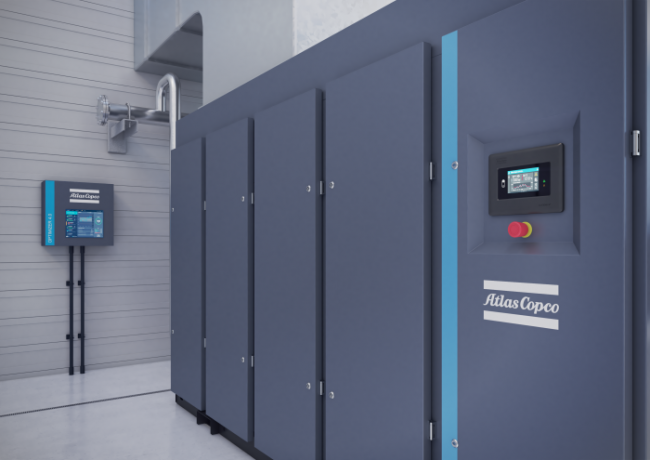7 minute read • published in partnership with Atlas Copco
Insight: How connected compressors are improving manufacturing
Digitalisation is having a transformative effect on industrial organisations. The combination of sensor-based data acquisition, wireless communication, and analytics gives plant engineers new insight into the performance of a broad range of assets. By knowing how machinery and systems are performing – often in real-time – it is possible to make informed decisions, streamlining operations and delivering cost savings to the bottom line. Paul Clark and Brian Barnes from Atlas Copco explain how intelligent solutions for connected compressors boost uptime and reduce production costs.
Connected compressors
Connected compressors are a great example of this exciting innovation. The latest technologies provide the means to check uptime, energy efficiency and machine health from remote locations via smartphones and other devices. This ability can help improve reliability and reduce energy usage across the factory floor and is the reason why connectivity should be considered as an essential factor in the specification of a new compressor.
Deploying this kind of Industrial Internet of Things (IIoT)-based intelligent capability inside a manufacturing organisation does not need to be costly, complex, or time-consuming. In fact, connectivity comes as standard on the latest generation of leading compressor brands, and it can be easily retrofitted to existing equipment. It therefore represents an immediate prospect for improved productivity and provides plant operators with the confidence and opportunity to kickstart a broader programme of digital transformation.

Manufacturers that use intelligent solutions for connected compressors can boost uptime and reduce production costs / Picture: Atlas Copco
But what kinds of connectivity solutions are available? And what sort of insight can they provide? Here are answers to some of the fundamental questions around connected compressors that will enable compressor users to gain smart insights quickly and cost-effectively.
Vital considerations
Compressed air is estimated to account for around 12 per cent of all energy used in industry globally – and it can be as high as 40 per cent in some facilities. It is a critical component in a modern factory, employed for an extensive range of applications, including powering pneumatic tools and operating within production lines. Ensuring the reliability of a compressed air supply, and optimising its use, are therefore vital considerations.
Knowing the status of compressed air equipment at all times acts as the best way to spot any developing problems, reveal potential energy savings, and deliver maximum uptime for compressors and production lines.
For many years now, smart controller technology has enabled plant managers to keep track of how compressors perform via MODBUS or PROFIBUS internet connections linked to a central plant management system. These types of control system acted as the ‘brain’ of a compressor: collecting data via built-in sensors, processing it, and then delivering plant managers with an overview of how their compressed air system is performing.
However, recent advances in digitalisation and the emergence of concepts such as Industry 4.0 have resulted in a step-change in smart manufacturing. Now, remote monitoring technologies make it possible to connect industrial equipment over a secure network to mobile devices, tablets, and smartphones. By facilitating remote monitoring, operators can keep track of key compressor performance parameters, including pressure, flow, motor and dryer speeds, and make adjustments when necessary via a compressor’s manual interface.
This capability provides plant managers with far more flexible and meaningful insight into their day-to-day operations and compressed air production– improving efficiency and saving energy. Let us look in greater detail at how this type of smart connectivity works and the benefits it delivers.
How smart connectivity works
In practice, a small sensor package, fitted to legacy equipment or integrated into new compressors, gathers data around a broad range of parameters such as run hours, temperature, oil temperature and pressure. On new, leading brand compressors the sensor comes as standard but for retrofit applications, where the sensor is not built-in, installation can be completed within a couple of hours.
The data is transmitted wirelessly, or via ethernet, to a central server where it is analysed and presented via a simple customer dashboard, highlighting information on ‘events,’ such as potential failure/pressure drops/required maintenance. When an operator wants to monitor the data locally, a smart visualisation and monitoring solution has been developed. This is for customers with machines connected over a controller area network who do not want their data transferred outside of their own network.
One of the latest developments of this technology is an easy-to-install, clamp-on unit for compressors rated up to 30 kW. No extra energy source is needed for its operation as it is simply attached to the incoming power cord to harvest energy from the machine while it is running.

By knowing how machinery and systems are performing – often in real-time – it is possible to make informed decisions, streamlining operations and delivering cost savings to the bottom line / Picture: Atlas Copco
How connected compressors deliver benefits
It is clear that connected compressors can be quickly and easily integrated into an intelligent production environment. But the collection and analysis of data only derive value when the information is used in a meaningful way. With the smart connectivity solution of one major compressor manufacturer, three levels of service are available, determined by the amount of information that is required. These levels are identified as service, uptime, and energy:
Service: More than 30 data points are actively monitored, providing insight into the health of the compressor by tracking all its vital signs. This information helps ensure that machines are kept in good condition, supporting the delivery of on-time service, the scheduling of planned visits and the creation of service reports. By sharing this information with compressor manufacturers, recommendations for performance enhancement can be made, together with general suggestions and advice.
With a maintenance contract, such as a total responsibility service plan, the equipment provider can take complete care of a customer’s compressed air equipment – providing on-time maintenance by service experts, genuine parts, upgrades, overhauls, and full risk coverage. It all contributes to optimal machine health, reduced costs and, ultimately, peace of mind.
Uptime: The sudden breakdown of equipment and machinery can result in lost production and reduced profitability. Having an early warning of potential problems, such as low oil or poor dryer quality, encourages a fast response, enabling customers to take action, and keep things running as planned. The smart monitoring system provides early warnings through alerts sent to computer or smartphone. Within the supplier’s range of service plans available, problems can also be proactively addressed.
Meanwhile, an essential guide to equipment health is indicated through integrated bearing condition monitoring delivered through SPM, the shock pulse method. This procedure keeps an eye on critical components and warns when they need to be replaced. Taking this informed approach to maintenance delivers maximum availability of machines, increasing customer uptime by at least 3%.
Energy: With compressed air accounting for a significant percentage of energy consumption within industrial facilities, the ability to analyse and optimise the energy efficiency of equipment is an important consideration.
This level of smart connectivity provides a range of information on energy consumption – from quick overviews on the dashboard or the ability to delve deeper for customised reports. Based on smart algorithms and expert analysis, proactive troubleshooting can be deployed to keep energy efficiency at an optimal level, encouraging the spotting and fixing of any deviations at an early stage. This information enables customers to save up to 30 per cent of power usage through improved energy efficiency, and it can act as a powerful means of complying with certification such as ISO50001.
Accessing data
Operational data, recommendations, alerts, service timeline and more are available via all-in connectivity platforms which are accessible on a computer, a tablet, or a smartphone. It allows subscribers to monitor, analyse and optimise their installation’s operational performance anytime and from anywhere.
A recent development in smart remote monitoring is a customisable mobile app that provides quick and easy access to compressor information. Together with air compressor manuals and service history, it provides the ability to book a visit by a service technician. Push notifications allow customers to keep compressed air systems in optimal condition. Any supplier’s machine can be added by serial number. Equipment does not have to be networked to access all available information – although connection via the cloud provides the best experience.
Smart connectivity in action – real-life customer applications
Smart connectivity is a proven technology that has been used by thousands of end-users in a broad range of industrial markets. In many cases, the foresight it has provided has helped avert serious consequences, ranging from equipment breakdown to over-heating and potential fire hazards.
Here is a selection of real-world customer applications:
Potential £6 million fire avoided at waste disposal and recycling company.
A shutdown event on motor overload occurred on a variable speed drive compressor at a waste disposal and recycling company. The diagnostics team monitored the event and issued a notification ticket on the same day. A suppliers technician visited the customer site to investigate the issue and found a loose connection at an incoming isolator. This was causing isolator burn and loss of one phase. The customer was about to recommission the plant following a £6 million fire, an event now potentially prevented from happening again.
Data patterns reveal high-temperature clues at a semiconductor plant.
By analysing smart data overtime at a semiconductor manufacturer, temperature readings of the element on an older compressor were consistently high. This pointed to the element becoming inefficient with age. The customer is now considering overhauling the old element, whilst the supplier’s service team keeps a close eye on the compressor data to ensure there is no downtime on site.
Frozen condensate drains that could have led to £80,000 breakdown cost.
A cold snap was caused a cereal manufacturer’s compressors to run at a particularly low ambient temperature. Smart technology picked up warnings from the units’ electronic condensate drains and initiated a service engineer’s site visit. This early intervention saw the customer fit temporary heaters, thus avoiding the drains freezing up. This could have led to compressor element damage and condensate reaching the air network. Furthermore, breakdown costs in the region of £80,000 were averted.
Dryer repair stops food manufacturer from getting in a jam.
A smart system identified a high dewpoint temperature on a dryer at a jam-maker. The compressor supplier’s system administrator immediately asked for a service engineer to be sent to the site to investigate. It transpired that there was a fault on the dryer, which the engineer was quickly able to repair. Wet air being passed into the jam-making process could have caused production problems, which were averted by smart connectivity intervention.

Connectivity and remote condition monitoring technology within compressed air equipment offers scope for further adoption and opportunities for the IIoT to enhance best practice / Picture: Atlas Copco
A transformative effect on industry
These examples provide a top-line view of how smart connected compressors are having a transformative effect on industry, can provide unprecedented levels of insight for plant engineers, drive operational improvements, and reduce costs.
The widespread adoption of the technology enables engineers to implement more predictive maintenance methodologies – where customisable data solutions are used to track patterns, identify anomalies, and organise a response, before a problem arises.
One compressor brand leader has around 200,000 connected compressors operating at around 100,000 customer sites in the world, delivering more than 150 data measurements per second.
Future developments in connected compressor technology
Looking to the future, the continued application of connectivity and remote condition monitoring technology within compressed air equipment offers scope for further adoption and opportunities for the IIoT to enhance best practice. This practice could ultimately lead to a situation where compressed air systems operate independently as cyber-physical systems, making autonomous adjustments to pressure and flow to facilitate process improvements.
This smart capability will not eliminate the role of the compressor operator; there will still be a vital position for humans in the control loop, acting as an interface between compressors and the wider smart factory environment. Ultimately, increased automation in manufacturing will not lead to the loss of employment opportunities, but it will no doubt create new and exciting roles.
Download Atlas Copco’s eBook ‘A beginners guide to connected compressors’ here
